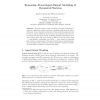Free Online Productivity Tools
i2Speak
i2Symbol
i2OCR
iTex2Img
iWeb2Print
iWeb2Shot
i2Type
iPdf2Split
iPdf2Merge
i2Bopomofo
i2Arabic
i2Style
i2Image
i2PDF
iLatex2Rtf
Sci2ools
IDA
1999
Springer
1999
Springer
Reasoning about Input-Output Modeling of Dynamical Systems
The goal of input-output modeling is to apply a test input to a system, analyze the results, and learn something useful from the causeeffect pair. Any automated modeling tool that takes this approach must be able to reason effectively about sensors and actuators and their interactions with the target system. Distilling qualitative information from sensor data is fairly easy, but a variety of difficult control-theoretic issues — controllability, reachability, and utility — arise during the planning and execution of experiments. This paper describes some representations and reasoning tactics, collectively termed qualitative bifurcation analysis, that make it possible to automate this task. 1 Input-Output Modeling System identification (SID) is the process of inferring an internal ordinary differential equation (ODE) model from external observations of a system. The computer program pret[5] automates the SID process, using a combination of artificial intelligence and system identi...
IDA 1999 | Information Management | Input-output Modeling | Input-Output Modeling System | Ode Model |
Related Content
| Added | 04 Aug 2010 |
| Updated | 04 Aug 2010 |
| Type | Conference |
| Year | 1999 |
| Where | IDA |
| Authors | Matthew Easley, Elizabeth Bradley |
Comments (0)

